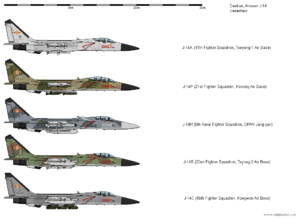Anseon J-14
This article is incomplete because it is pending further input from participants, or it is a work-in-progress by one author. Please comment on this article's talk page to share your input, comments and questions. Note: To contribute to this article, you may need to seek help from the author(s) of this page. |
| Anseon J-14 | |
|---|---|
 Main J-14 variants | |
| General information | |
| Type | fighter, Multirole Fighter |
| Manufacturer | Anseon Aerodynamics |
| Status | In service |
| History | |
| Manufactured | 1992-today |
| Introduction date | 4 June 1992 |
The Anseon J-14 is a Daekanese all weather, twin-engine fighter aircraft designed by Anseon Aerodynamics (formerly Anseon Aircraft Corporation). It was developed as large fourth-generation air superiority fighter, specifically a counter to the Esgonian 2K3-74. It has a very long-rage, is equipped with powerful radar and sophisticated avionics, and can be armed with a variety of ordnance. Its main role was initially air superiority and long-range bomber escort, however several mutlirole variants were also developed.
Origins and development
The study for a large, twin-engine tactical fighter for the DPAAF began with the economic upturn of the mid-1980s brought about by Premier Maeng's policies Hyeogsin policies. It was intended that such a fighter would act as a counter to the Esgonian 2K3-74 that had entered service in 1976, as well as perform a long-range interceptor role against long-range Urranese bombers such as the B-1. The initial intent was to purchase the Sukhoi Su-27 from Vanquaria, however Daekanese aerospace companies and design bureaus that had recently become more independent, lobbied that the new fighter should be of domestic design and production. In 1986, the National Defence Council and the Ministry of Defence started a competition for domestic companies to draft their own designs and prototypes to be pitched against the Su-27.
The two major Daekanese fighter designers, the Anseon Aircraft Corporation and the Sangnam Aircraft Design Bureau, produced prototypes of their designs as early as 1987, while other companies also followed. Anseon's prototype, dubbed the Mae (Falcon), was pitted against the prototypes of other companies in a demonstaration antended by DPA and Party officials in 1988. The Mae impressed officials with its payload capability and maneuverability, and Anseon won the contract. The fighter was given the prototype designation W-014-1, and later the in-service designation of J-14. The success of the competition also prompted the creation of a lightweight tactical fighter competition to complement the J-14, and supplament and eventually replace the Sangnam J-9.
Design
Overview
The J-14 has an all-metal semi-monocoque fuselage and shoulder mounted wings. The wings have a cranked arrow delta-style shape, with the leading edge being swept back more than the rest of the wing. The vertical stabilizers are slightly tilted outwards, while the horizontal all-moving tails provide increased roll control during maneuvers. The tail is of composite and metal construction, and the air break is spine-mounted behind the cockpit. The J-14 has a retractable tricycle landing gear design. The aircraft's relatively low wing loading and advanced flight controls allow for increased agility and maneuverability. Different variatnts of the J-14 introduce additional design elements. The carrier-based J-14H features canards, which provide additional lift and shorten take-off distance, allowing the fighter to operate from the ramp-equipped DPA Navy carriers. The P variants (J-14P, J-14BP, J-14HP, J-14CP) feature a second seat behind the pilot for a weapon systems officer (WSO).
Engines
Electronics and Avionics
Operational history
Variants
Users
 Daekan: The Daekanese People's Army Air Force (DPAAF) operates 120 J-14s of mostly J-14B and J-14C variants. The Daekanese People's Army Navy (DPAN) operates an additional 40 J-14H variants off its carriers.
Daekan: The Daekanese People's Army Air Force (DPAAF) operates 120 J-14s of mostly J-14B and J-14C variants. The Daekanese People's Army Navy (DPAN) operates an additional 40 J-14H variants off its carriers.
Specifications (J-14B)
General characteristics
- Crew: 1: pilot
- Length: 20.55 ()
- Wingspan: 13.47 ()
- Height: 5.26 m ()
- Empty weight: 13,000 kg ()
- Max. takeoff weight: 31,500 kg ()
- Powerplant: 2 × Gangwon TP-400-2 afterburning turbofan
Performance
- Maximum speed: Mach 2.6 (3,210 km/h, 1,994 mph) at high altitude/ Mach 1.2 (1,481 km/h, 920 mph) at low altitude
- Range: 2,700 at altitude ()
- Ferry range: 5,500 km with fuel tanks ()
- Service ceiling: 20,000 m (59,000 ft)
- Rate of climb: 290 m/s ()
Armament
- Guns: Provision for 1 × 30 mm Gryazev-Shipunov GSh-30-1 autocannon with 150 rounds
- Hardpoints: Total of 11: 4 (two pylons with two rails) under-wing, 4 under-fuselage, 3 centerline; with a capacity of 7,300 kg (16,093 lb) external fuel and ordnance. and provisions to carry combinations of:
- Missiles:
- Air-to-air missiles:
- Air-to-surface missiles
- Bombs:
- MP series of dumb bombs (250 kg and 500 kg bombs)
- GB series of dumb bombs (150 kg, 250 kg, 500 kg and 700 kg bombs)
- YP-5 laser guided bomb
- GGB series of laser guided bombs (250 kg, 500 kg and 700 kg bombs)
- GP-7 glide bomb
- Other:
- LP-20 rocket pod
- LP-32 rocket pod
- Various fuel tanks (up to 3)
- Missiles:
Avionics
TBA